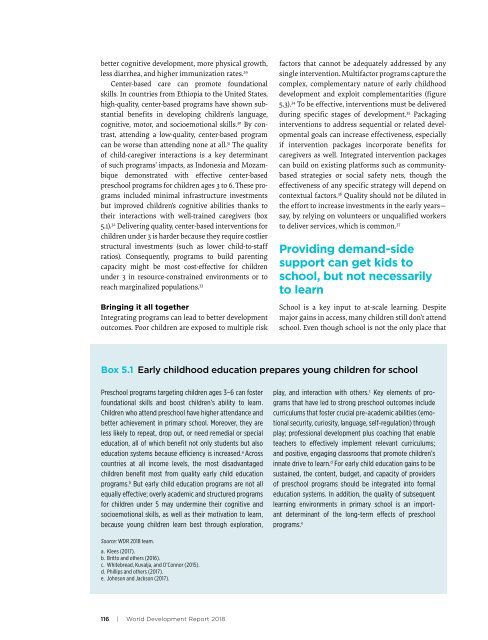Brasil só deve dominar Leitura em 260 anos, aponta estudo do Banco Mundial Relatorio Banco Mundial _Learning
You also want an ePaper? Increase the reach of your titles
YUMPU automatically turns print PDFs into web optimized ePapers that Google loves.
etter cognitive <strong>deve</strong>lopment, more physical growth,<br />
less diarrhea, and higher immunization rates. 29<br />
Center-based care can promote foundational<br />
skills. In countries from Ethiopia to the United States,<br />
high-quality, center-based programs have shown substantial<br />
benefits in <strong>deve</strong>loping children’s language,<br />
cognitive, motor, and socio<strong>em</strong>otional skills. 30 By contrast,<br />
attending a low-quality, center-based program<br />
can be worse than attending none at all. 31 The quality<br />
of child-caregiver interactions is a key determinant<br />
of such programs’ impacts, as In<strong>do</strong>nesia and Mozambique<br />
d<strong>em</strong>onstrated with effective center-based<br />
preschool programs for children ages 3 to 6. These programs<br />
included minimal infrastructure investments<br />
but improved children’s cognitive abilities thanks to<br />
their interactions with well-trained caregivers (box<br />
5.1). 32 Delivering quality, center-based interventions for<br />
children under 3 is harder because they require costlier<br />
structural investments (such as lower child-to-staff<br />
ratios). Consequently, programs to build parenting<br />
capacity might be most cost-effective for children<br />
under 3 in resource-constrained environments or to<br />
reach marginalized populations. 33<br />
Bringing it all together<br />
Integrating programs can lead to better <strong>deve</strong>lopment<br />
outcomes. Poor children are exposed to multiple risk<br />
factors that cannot be adequately addressed by any<br />
single intervention. Multifactor programs capture the<br />
complex, compl<strong>em</strong>entary nature of early childhood<br />
<strong>deve</strong>lopment and exploit compl<strong>em</strong>entarities (figure<br />
5.3). 34 To be effective, interventions must be delivered<br />
during specific stages of <strong>deve</strong>lopment. 35 Packaging<br />
interventions to address sequential or related <strong>deve</strong>lopmental<br />
goals can increase effectiveness, especially<br />
if intervention packages incorporate benefits for<br />
caregivers as well. Integrated intervention packages<br />
can build on existing platforms such as communitybased<br />
strategies or social safety nets, though the<br />
effectiveness of any specific strategy will depend on<br />
contextual factors. 36 Quality should not be diluted in<br />
the effort to increase investments in the early years—<br />
say, by relying on volunteers or unqualified workers<br />
to deliver services, which is common. 37<br />
Providing d<strong>em</strong>and-side<br />
support can get kids to<br />
school, but not necessarily<br />
to learn<br />
School is a key input to at-scale learning. Despite<br />
major gains in access, many children still <strong>do</strong>n’t attend<br />
school. Even though school is not the only place that<br />
Box 5.1 Early childhood education prepares young children for school<br />
Preschool programs targeting children ages 3–6 can foster<br />
foundational skills and boost children’s ability to learn.<br />
Children who attend preschool have higher attendance and<br />
better achiev<strong>em</strong>ent in primary school. Moreover, they are<br />
less likely to repeat, drop out, or need r<strong>em</strong>edial or special<br />
education, all of which benefit not only students but also<br />
education syst<strong>em</strong>s because efficiency is increased. a Across<br />
countries at all income levels, the most disadvantaged<br />
children benefit most from quality early child education<br />
programs. b But early child education programs are not all<br />
equally effective; overly acad<strong>em</strong>ic and structured programs<br />
for children under 5 may undermine their cognitive and<br />
socio<strong>em</strong>otional skills, as well as their motivation to learn,<br />
because young children learn best through exploration,<br />
play, and interaction with others. c Key el<strong>em</strong>ents of programs<br />
that have led to strong preschool outcomes include<br />
curriculums that foster crucial pre-acad<strong>em</strong>ic abilities (<strong>em</strong>otional<br />
security, curiosity, language, self-regulation) through<br />
play; professional <strong>deve</strong>lopment plus coaching that enable<br />
teachers to effectively impl<strong>em</strong>ent relevant curriculums;<br />
and positive, engaging classrooms that promote children’s<br />
innate drive to learn. d For early child education gains to be<br />
sustained, the content, budget, and capacity of providers<br />
of preschool programs should be integrated into formal<br />
education syst<strong>em</strong>s. In addition, the quality of subsequent<br />
learning environments in primary school is an important<br />
determinant of the long-term effects of preschool<br />
programs. e<br />
Source: WDR 2018 team.<br />
a. Klees (2017).<br />
b. Britto and others (2016).<br />
c. Whitebread, Kuvalja, and O’Connor (2015).<br />
d. Phillips and others (2017).<br />
e. Johnson and Jackson (2017).<br />
116 | World Development Report 2018








